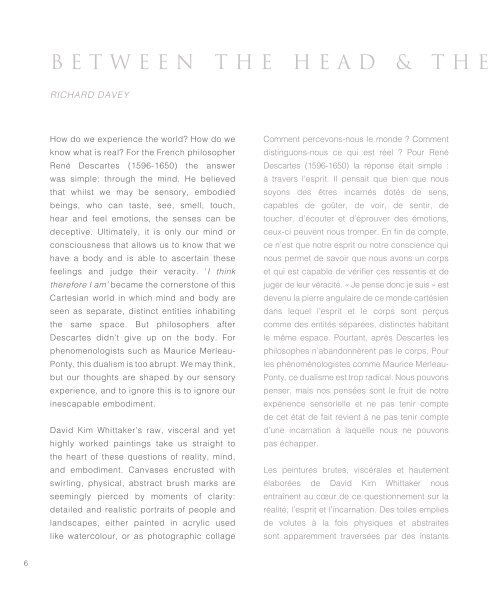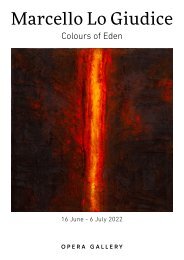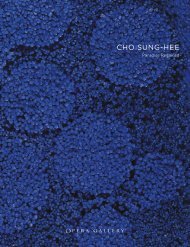David Kim Whittaker 'The Flesh to The Frame'
You also want an ePaper? Increase the reach of your titles
YUMPU automatically turns print PDFs into web optimized ePapers that Google loves.
BETWEEN THE HEAD & THE<br />
RICHARD DAVEY<br />
How do we experience the world? How do we<br />
know what is real? For the French philosopher<br />
René Descartes (1596-1650) the answer<br />
was simple: through the mind. He believed<br />
that whilst we may be sensory, embodied<br />
beings, who can taste, see, smell, <strong>to</strong>uch,<br />
hear and feel emotions, the senses can be<br />
deceptive. Ultimately, it is only our mind or<br />
consciousness that allows us <strong>to</strong> know that we<br />
have a body and is able <strong>to</strong> ascertain these<br />
feelings and judge their veracity. 'I think<br />
therefore I am’ became the corners<strong>to</strong>ne of this<br />
Cartesian world in which mind and body are<br />
seen as separate, distinct entities inhabiting<br />
the same space. But philosophers after<br />
Descartes didn’t give up on the body. For<br />
phenomenologists such as Maurice Merleau-<br />
Ponty, this dualism is <strong>to</strong>o abrupt. We may think,<br />
but our thoughts are shaped by our sensory<br />
experience, and <strong>to</strong> ignore this is <strong>to</strong> ignore our<br />
inescapable embodiment.<br />
<strong>David</strong> <strong>Kim</strong> <strong>Whittaker</strong>’s raw, visceral and yet<br />
highly worked paintings take us straight <strong>to</strong><br />
the heart of these questions of reality, mind,<br />
and embodiment. Canvases encrusted with<br />
swirling, physical, abstract brush marks are<br />
seemingly pierced by moments of clarity:<br />
detailed and realistic portraits of people and<br />
landscapes, either painted in acrylic used<br />
like watercolour, or as pho<strong>to</strong>graphic collage<br />
Comment percevons-nous le monde ? Comment<br />
distinguons-nous ce qui est réel ? Pour René<br />
Descartes (1596-1650) la réponse était simple :<br />
à travers l’esprit. Il pensait que bien que nous<br />
soyons des êtres incarnés dotés de sens,<br />
capables de goûter, de voir, de sentir, de<br />
<strong>to</strong>ucher, d’écouter et d’éprouver des émotions,<br />
ceux-ci peuvent nous tromper. En fin de compte,<br />
ce n’est que notre esprit ou notre conscience qui<br />
nous permet de savoir que nous avons un corps<br />
et qui est capable de vérifier ces ressentis et de<br />
juger de leur véracité. « Je pense donc je suis » est<br />
devenu la pierre angulaire de ce monde cartésien<br />
dans lequel l’esprit et le corps sont perçus<br />
comme des entités séparées, distinctes habitant<br />
le même espace. Pourtant, après Descartes les<br />
philosophes n’abandonnèrent pas le corps. Pour<br />
les phénoménologistes comme Maurice Merleau-<br />
Ponty, ce dualisme est trop radical. Nous pouvons<br />
penser, mais nos pensées sont le fruit de notre<br />
expérience sensorielle et ne pas tenir compte<br />
de cet état de fait revient à ne pas tenir compte<br />
d’une incarnation à laquelle nous ne pouvons<br />
pas échapper.<br />
Les peintures brutes, viscérales et hautement<br />
élaborées de <strong>David</strong> <strong>Kim</strong> <strong>Whittaker</strong> nous<br />
entraînent au cœur de ce questionnement sur la<br />
réalité; l’esprit et l’incarnation. Des <strong>to</strong>iles emplies<br />
de volutes à la fois physiques et abstraites<br />
sont apparemment traversées par des instants<br />
6

















